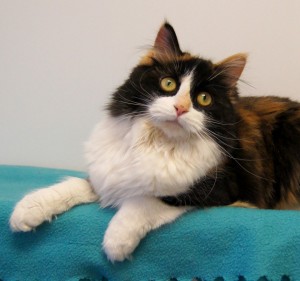 It’s that time of the year again: sunny days bring blooming flowers, pollinating trees…and people surrendering their cats.
It’s that time of the year again: sunny days bring blooming flowers, pollinating trees…and people surrendering their cats.
We get calls from people who have been told by their doctors the only way to breathe more easily is to get rid of their cats. Is this really your only option?
At Happy Cats Haven, we don’t think so. Many of us have allergies–to cats as well as other things–and have found ways to live with them as well as our cat families.
Here are 7 tips about cats & allergies your doctor may not tell you about:
- Non-cat allergens may also be living in your home. Many products marketed to “freshen” the air actually create a chemical stew that can make your allergies worse. These include not only “air fresheners” such as plug-ins but scented candles and so-called “odor eliminators” that add unregulated perfumes. Manufacturers aren’t require to list fragrance ingredients, which can contain volatile organic compounds (VOCs) that can be carcinogenic at worst…and allergenic at best. Even natural incense can produce allergies.
- Litter may be the culprit. Many of us have noticed a huge difference in our allergies by switching from clay litters to other natural materials like wheat, corn or nut hulls. They are often less dusty, which means less dust on your cat, so less dust on you. And those scented litters? They put unregulated VOCs right where they can do the most damage, both to you and your cat. How unfair is it to blame your cat for allergies when you’re the one in charge of his or her litter?
- Check your cleaning products. One study found 457 air contaminants in 24 common household cleaners. Again, the companies don’t have to reveal what they’re using and many of these chemicals are allergenic and downright dangerous. This of course includes pet bathing ingredients, which are even less regulated. If your allergies get worse during or after cleaning, you may want to look into more natural solutions.
- Allergies are cumulative. If you have seasonal allergies to pollen, they will probably be worse in the spring and fall. This allergy load may make you allergic to cats and other animals at that time. Take steps to lower the load and you may find that the allergy passes, or becomes easier to live with. We wonder how many people give up their feline friends only to find those allergies come right back during the next pollinating season?
- Dust in the wind. If the wind is on a Spring rampage, kicking up dust as it does in the Pikes Peak region, your allergies may also kick in. Make sure your house is clean, including where your cats hang out, so they don’t become dust magnets and make your allergies worse. An inexpensive air filter can work magic during the allergy season and may not be something you even need during the rest of the year.
- Find another place for your cat to sleep. One of our favorite things is falling asleep to the sound of a happy cat purr. However, if you truly are allergic to your cat, keeping him away from the bedroom where you get the closest, most intense exposure can be a very logical solution. If your kitty is used to sleeping with you, it may take some time to make another space as valuable to him as the bedroom, but compared to rehoming or euthanasia, this is a much more kind and less drastic solution.
- Brush your cat. This almost goes without saying, but sometimes our cat friends can use some help, especially our longhairs. If done correctly, brushing can be an extension of petting time, rather than something your cat dreads. This will limit the fur load in your house and thus, the allergens. It will also help limit fearful trips to the groomer. We have tips for making grooming a pleasant experience, including using clicker training to help.
These can be life-or-death solutions for our animal friends (some point fingers at cats, but many people are also allergic to dogs). We have more suggestions, including diet and supplement help, in our other article, Don’t Let Allergies Steal Your Cat. See the link below for easy, natural cleaning products. Please call if we can help!
Potera, C. (2011) Indoor air quality: scented products emit a bouquet of VOCs. Retrieved from: http://www.ncbi.nlm.nih.gov/pmc/articles/PMC3018511/
Consumer Reports Magazine (2012) Is poor indoor air quality making you sick? Retrieved from: http://www.consumerreports.org/cro/magazine/2012/06/is-poor-indoor-air-quality-making-you-sick/index.htm
Healthy Child, Healthy World (2011) Air fresheners’ real impact on indoor air quality. Retrieved from: http://blogs.webmd.com/health-ehome/2011/04/air-fresheners-real-impact-on-indoor-air-quality.html
Bold, Cambria (2014) 20 DIY green cleaning recipes. Retrieved from: http://www.apartmenttherapy.com/20-diy-green-cleaning-recipes-141129
Lundgren, L. and Wald., J. (2014) How to allergy-proof your home. Retrieved from: http://health.howstuffworks.com/diseases-conditions/allergies/indoor-allergies/how-to-allergy-proof-your-home2.htm





